The Unintentional Watch Collector: An Unplanned Watch Collection Spanning Eight Decades
A common theme regularly covered by (predominantly) male writers in the watch blogosphere is how their interest in watches was influenced or even triggered by their fathers and/or grandfathers and what they wore on their wrist(s). Several online publications run regular features along the lines of “How I Rescued/Restored my Father’s/Grandfather’s Watch” as well as the popular “Reunited with my First Watch” theme – both of which I have also shared with Quill & Pad’s readers over the last few years.
I never set out to collect watches; I suspect that deep down I aspire to being a one-watch guy. In fact, I have only gone out and bought myself a new watch on two occasions in my life. Nevertheless, through a combination of new and used purchases, gifts, hand-me-downs, and inherited pieces, I have managed to accumulate a selection of watches that rather neatly spans eight consecutive decades of the twentieth and twenty-first centuries.
These are the watches that I wear on a regular basis, keep maintained and serviced, and have no intention of selling. I suppose that constitutes a collection.
1940s: Ebel Automatic (Caliber 93)
This Ebel Automatic is my only “dress watch.” It is a precious family heirloom that my grandfather bought for my father on his twenty-first birthday as confirmed by the invoice from Regent’s Jewellers, London, dated 1949.
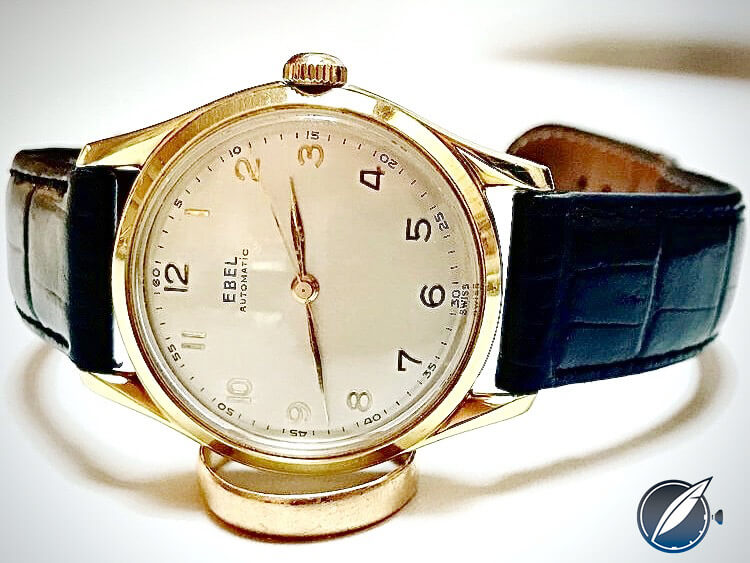
Ebel Automatic (photo courtesy Colin Alexander Smith)
At 36 mm it is relatively large for the period, and I find the spacious dial layout particularly attractive, even soothing to look at. The gold-plated case’s “Bombay” lugs add a twist of character, a feature seen on some Rolex Oyster Perpetuals of the same period.
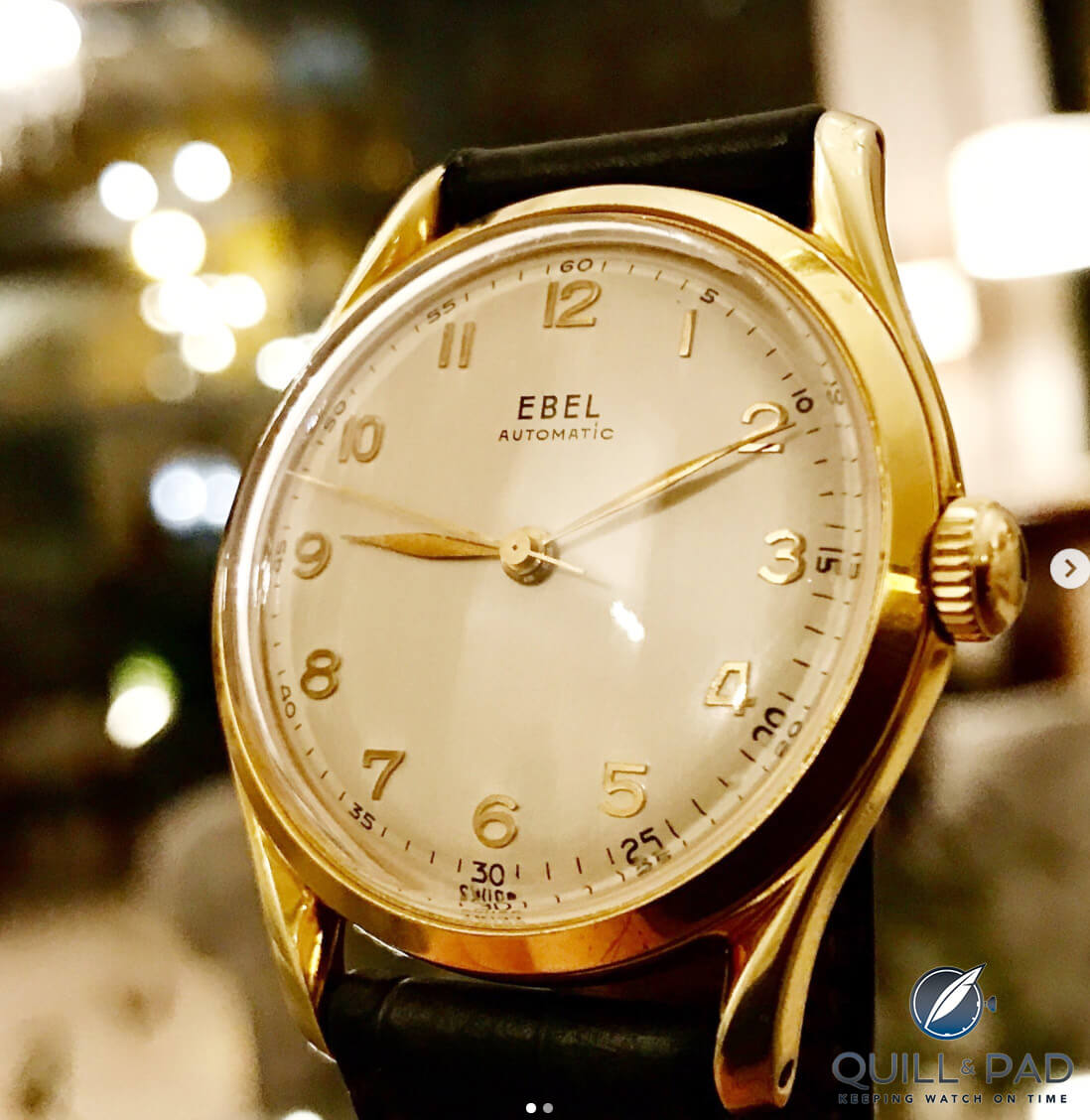
Ebel Automatic (photo courtesy Colin Alexander Smith)
I have no recollection of my father ever wearing this watch, and there is no sign of him wearing it in photos from the 1950s or 1960s; I had no idea that it even existed until after he died. Which explains why it is still in pristine condition more than 70 years later.
The Ebel Caliber 93 features a bumper rotor. I had it serviced a few years ago by Bordeaux-based watchmaker Jean-Louis Strack, who enthused about it being a real “mouvement de manufacture.”
1955: Rolex Oyster Perpetual Date Officially Certified Chronometer (Caliber 1030)
French journalist Jacques Seguela famously once said, “If you haven’t got a Rolex by the time you’re 50, you’ve failed in life.” If this is true, then I arrived late to the party. But better to arrive late than never.
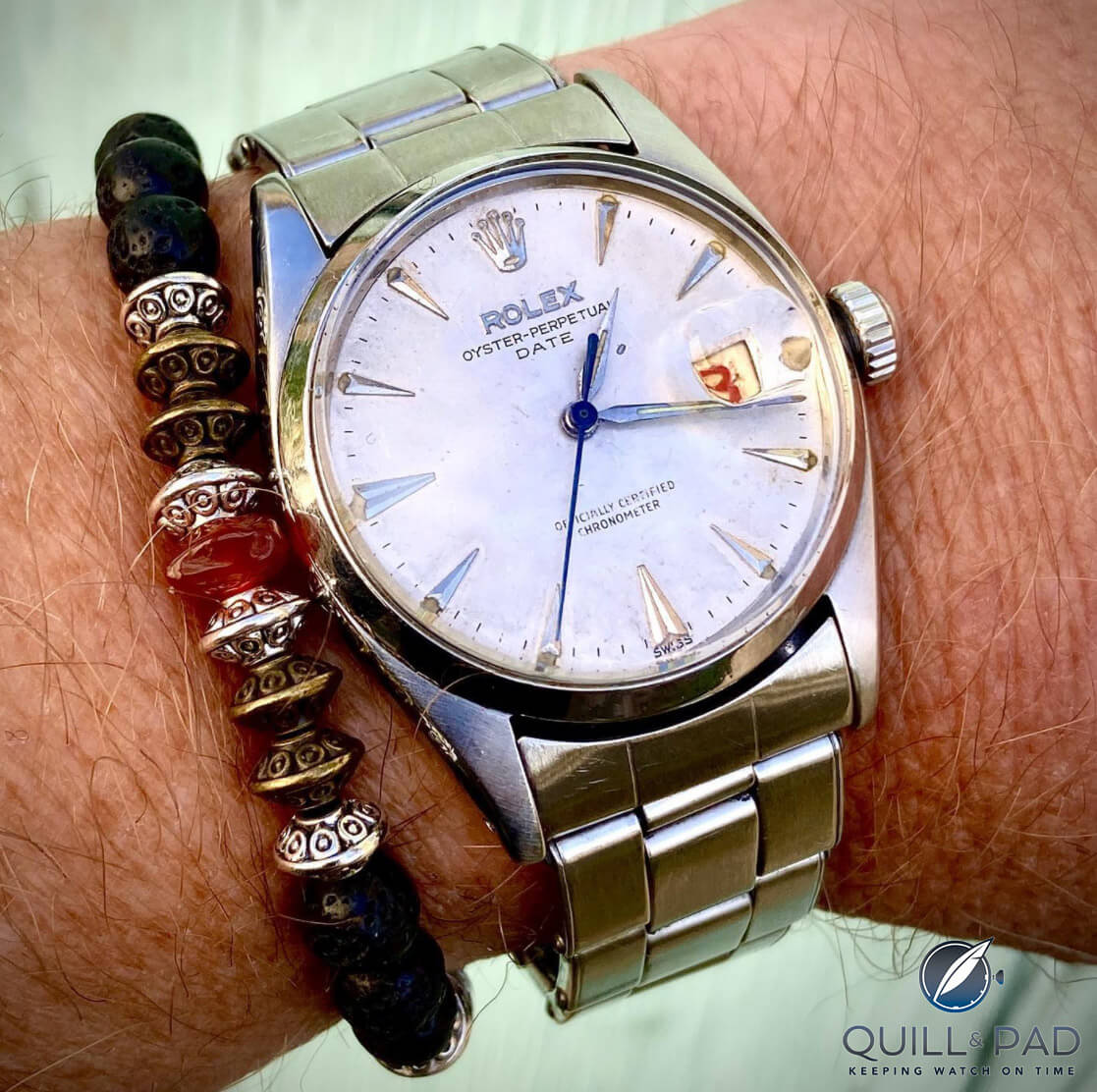
Rolex Oyster Perpetual Date (photo courtesy Colin Alexander Smith)
I treated myself to this, my first Rolex, three years ago after peering into a drawer full of vintage watches that I had picked up at flea markets over the last few years and restored, realizing that although none of them were particularly valuable, collectively they would fetch a tidy sum.
A few months later I had realized said sum and managed to pick up at auction a slightly sorry-looking 1955 Rolex Oyster Perpetual Date for, if not a song, a few snatches of a melody. Among other things, the dial featured the partial thumbprint of a sweaty (probably amateur) watchmaker, and the movement ground to a halt after a month or so.
I treated the case and bracelet to an ultrasound cleaning, removed the sweaty thumbprint with Rodico and had the movement serviced and fitted with a new mainspring by a professional watchmaker. I gave the (reassuringly thick) crystal and its Cyclops date window a deep sanding and polishing to eradicate every last scratch, and the watch now looks splendid, a timeless classic that looks as good with a suit and tie as it does with jeans and a t-shirt.
The Oyster bracelet fits me fine in the winter but is just a bit tight in summer, so I wear the watch on a handmade leather Zulu strap or a Gay Frères bonklip bracelet.
1964: Black Dial Omega Constellation Officially Certified Chronometer
This Omega Constellation is my hand-me-down piece – my father claimed to have bought this watch in Singapore in 1964 and wore it continuously thereafter, eventually putting it away in a drawer in the late 1990s after it ground to a halt. He gave it to me in 2001 and said I could keep it if I could get it going again, which a local watchmaker duly did for the princely sum of £60, thereby triggering my discovery of the Omega forums and my subsequent descent into the horological rabbit hole.
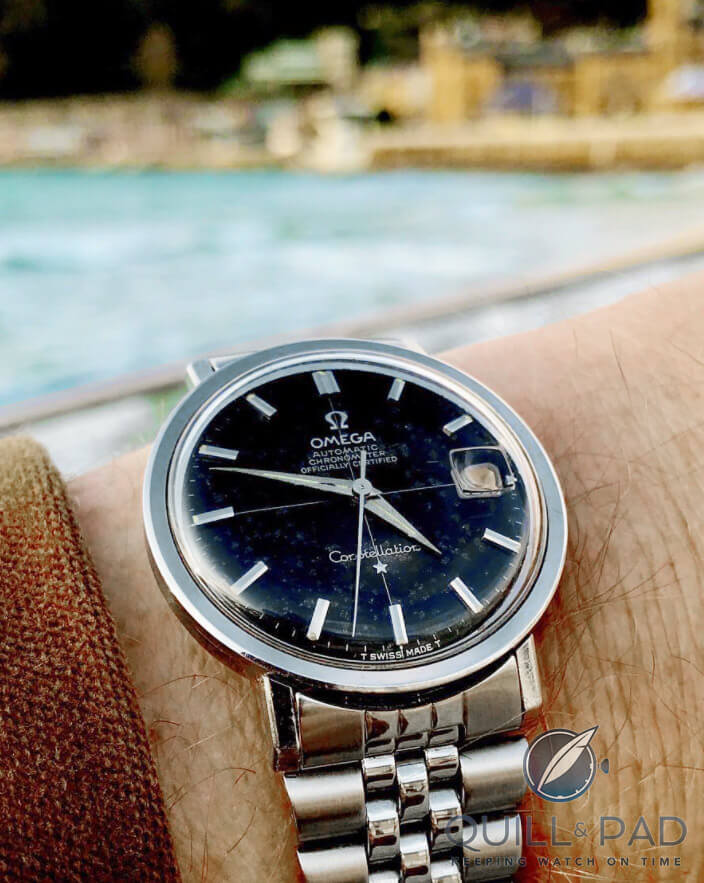
Omega Constellation (photo courtesy Colin Alexander Smith)
As the watch spent the first ten years of its life in the jungles of Borneo and the deserts of Oman, the dial is genuinely “tropical,” having deteriorated into an attractive pattern reminiscent of a starry nighttime sky. Although I have several of my father’s watches, this Omega is definitely “the one” as it was ever-present throughout my childhood.
Many would say that a vintage Constellation should be on a beads-of-rice bracelet, but the straight-lug “disco volante” case design with its recessed crown is very different from the standard 1950s Constellation designs, so I wear it on a ZRC Jubilee bracelet or on a tan ostrich strap. Its Caliber 564 is extremely accurate (but definitely due for its next service).
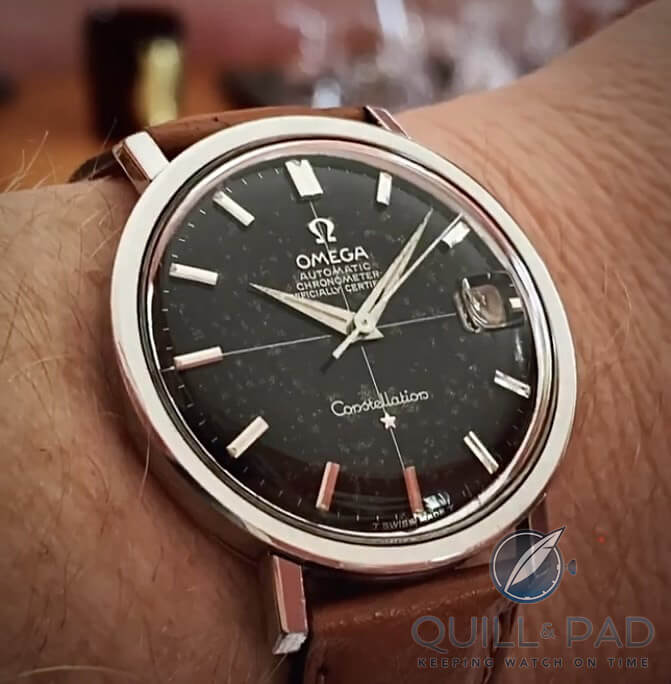
Omega Constellation (photo courtesy Colin Alexander Smith)
Since we are discussing the 1960s here, I have to mention my first watch, bought for me on my seventh birthday: my West End Watch Co. Sowar Prima with which I was reunited unexpectedly two years ago. Not part of my prime collection as I don’t wear it much due to its small size, but a precious item nevertheless.
1979: Seiko 7205 8212P, Daini factory
This Seiko is the first watch I bought myself with my first paycheck after leaving school in 1979 for the princely sum of £29. With hindsight, I like to brag that I must have already had something of an “eye” for watches at the age of 17, choosing an automatic, blue-dial, stainless steel sports watch.
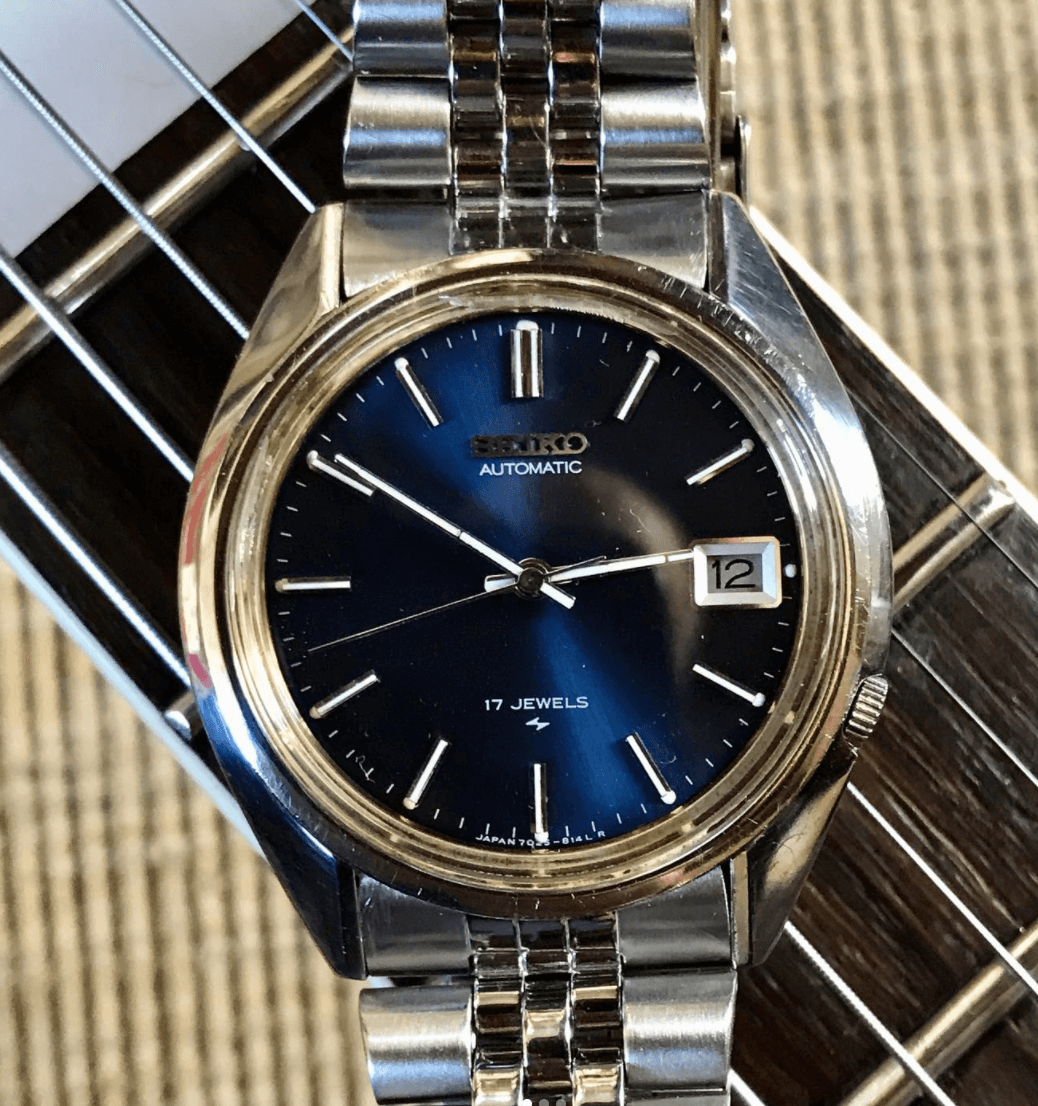
Seiko 7205 8212P (photo courtesy Colin Alexander Smith)
I have worn it off and on over the last 40 years, notably taking a break when the receptionist at the firm I worked for in London’s Docklands told me that watches with blue dials “reminded her of old men in pubs.” Although rated no more than “water resistant,” I regularly wore it while swimming, windsurfing, and fishing until the 2000s, when it began to show signs of condensation.
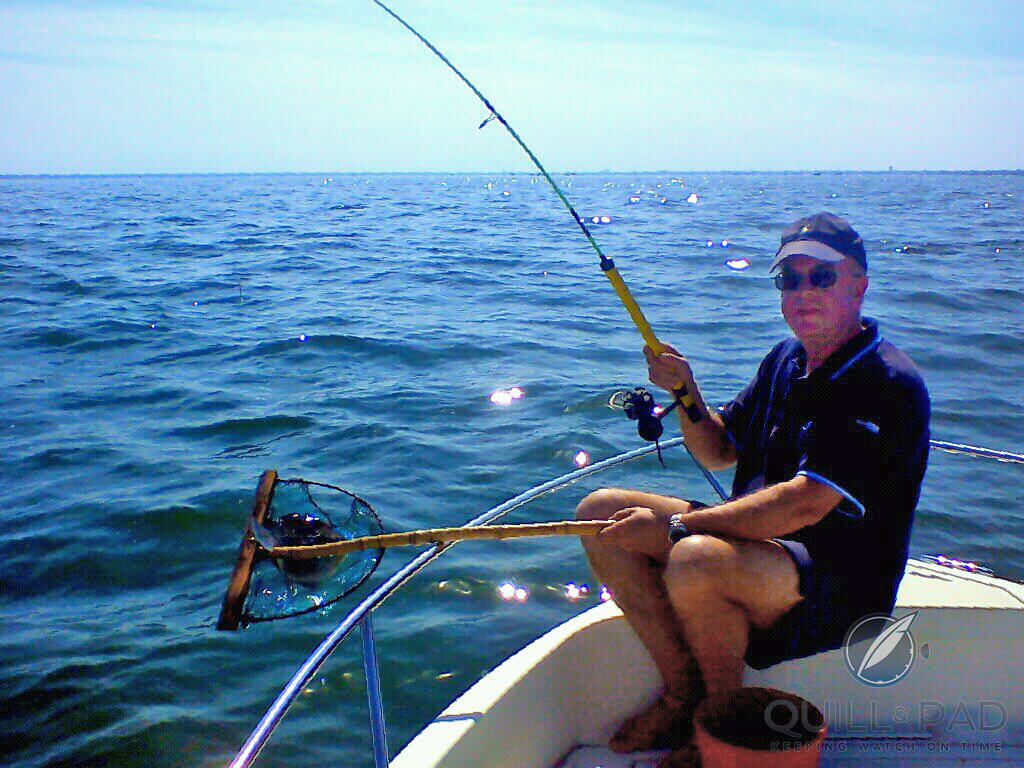
Colin Alexander Smith fishing with the Seiko 7205 8212P (photo courtesy Colin Alexander Smith)
I had the watch serviced once in the mid-1990s and serviced it again myself two years ago. The 7025 movement runs at a steady +/- one second per day, outperforming my Rolex and Omega certified chronometers.
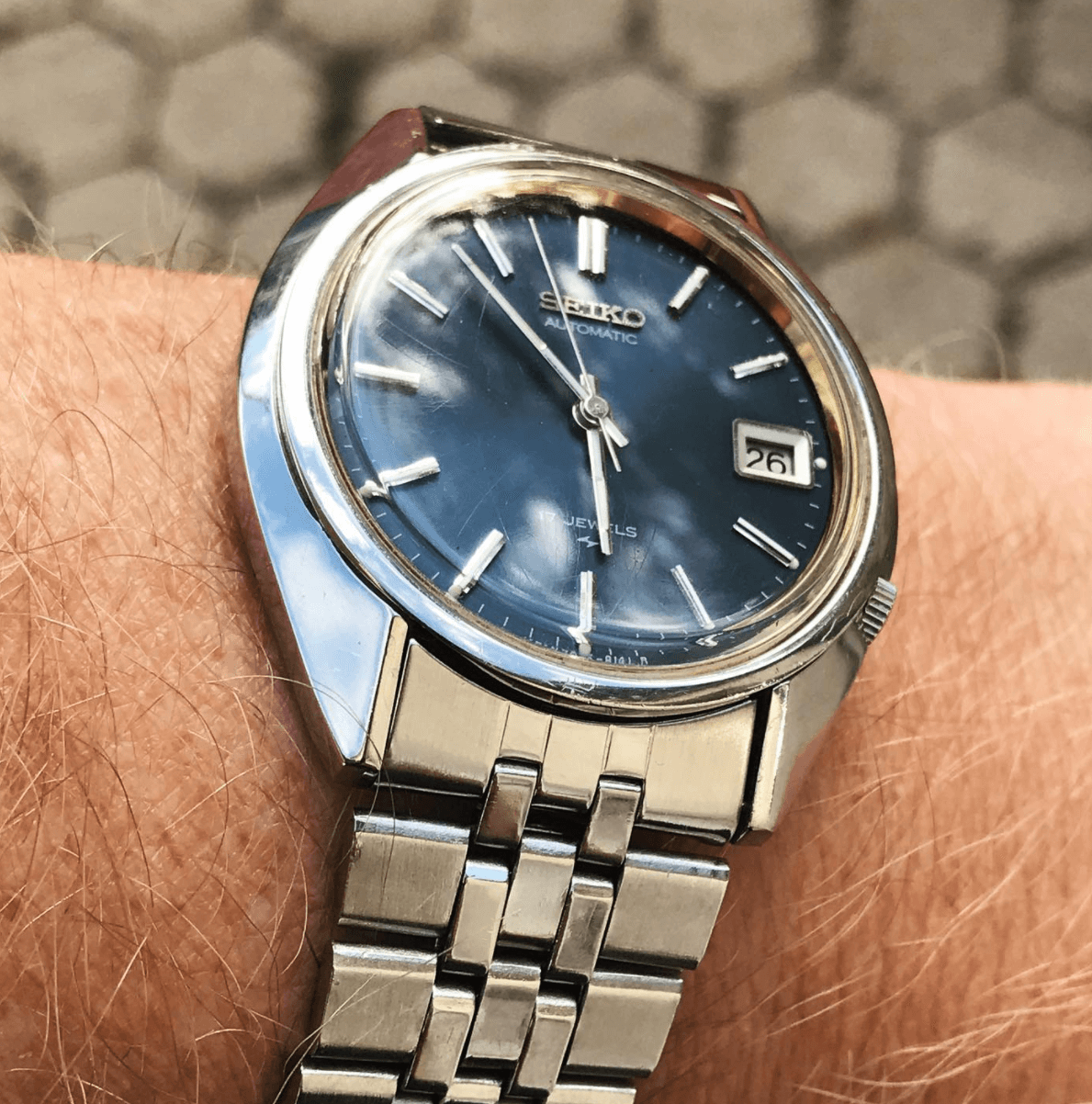
Seiko 7205 8212P (photo courtesy Colin Alexander Smith)
I like to call it my “Grand Seiko” partly because the movement is so accurate and also because it sports the classic 44GS case and was made by the Seiko Daini factory. According to Seiko historians David Flett and Pedro Mendes, “Initially Daini were asked to produce Grand Seiko because of one particularly accurate King Seiko model. The manually wound 44KS was powered by the 4402 movement, which was fittingly a development of Daini’s original Caliber 54 created many years earlier as an answer to Suwa’s own Marvel. The Daini 4402 movement was so good that Daini were asked to use it to create a Grand Seiko, the 44GS, now appreciated as one of the all-time great vintage Seikos.”
Not bad for £29 . . .
1989: Sector ADV1000 Quartz
Although I bought this Sector in 1993, I consider it to be my classic 1980s piece. And it is the only other new watch I have bought myself, partly in response to my abovementioned “blue dial” crisis and partly to celebrate the birth of my daughter. You can read the full story about my acquisition of this watch here.
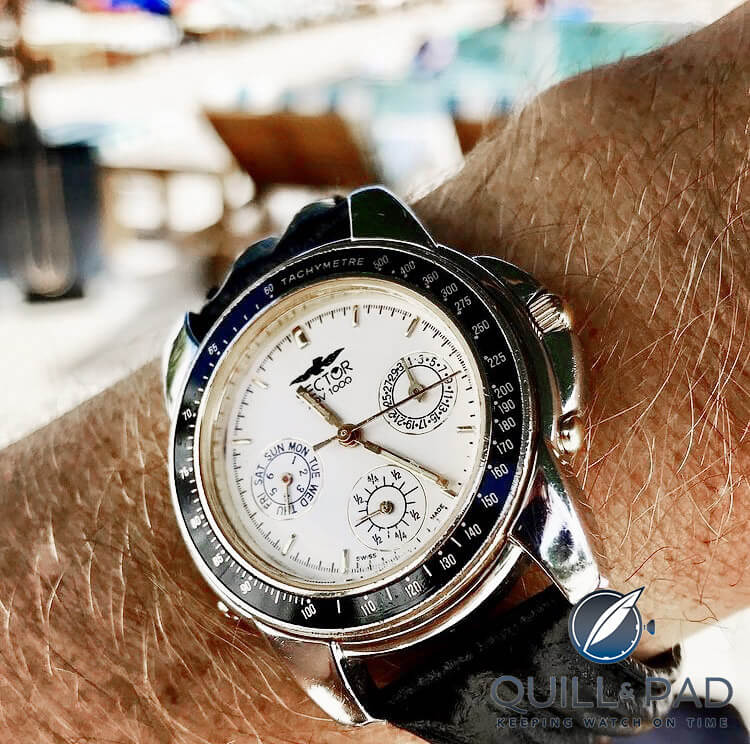
Sector ADV1000 (photo courtesy Colin Alexander Smith)
Sector as a brand subsequently went downhill after abandoning Swiss-made watches in the pursuit of brash designs and a low-cost, Invicta style. But to this day it remains one of my favorite watches simply because it’s solidly built and I like the look of it. And it’s handy to have at least one quartz watch ticking away in the drawer, which I can just pick up and wear without winding or setting.
I also find I am increasingly in need of a day-date function as Wednesdays and Thursdays frequently blur into a sort of mid-week haze. The Ronda 706 five-jewel movement features a moon phase indicator at 6 o’clock, which Sector replaced with a pointer dial, a refreshing change from the standard buttocks-shaped moon phase window with deranged halfwit half-moon face grinning out at you.
1997: Tissot PR100 automatic
This Tissot PR100 automatic is another inheritance piece, being the last “proper” watch my father bought himself in 1997 (probably around the time of the demise of his Omega Constellation). Apart from looking incredibly smart with its crisp white “Buckley” dial and dodecagonal bezel, as a watch it ticks pretty much every box you can think of: automatic ETA 2892-2 movement running at 28,800 vph, hacking seconds, day and date, screw-down crown, crown guards, handsomely engraved case back, very solid Jubilee-style bracelet with security clasp, sapphire crystal, and 100 m water resistance.
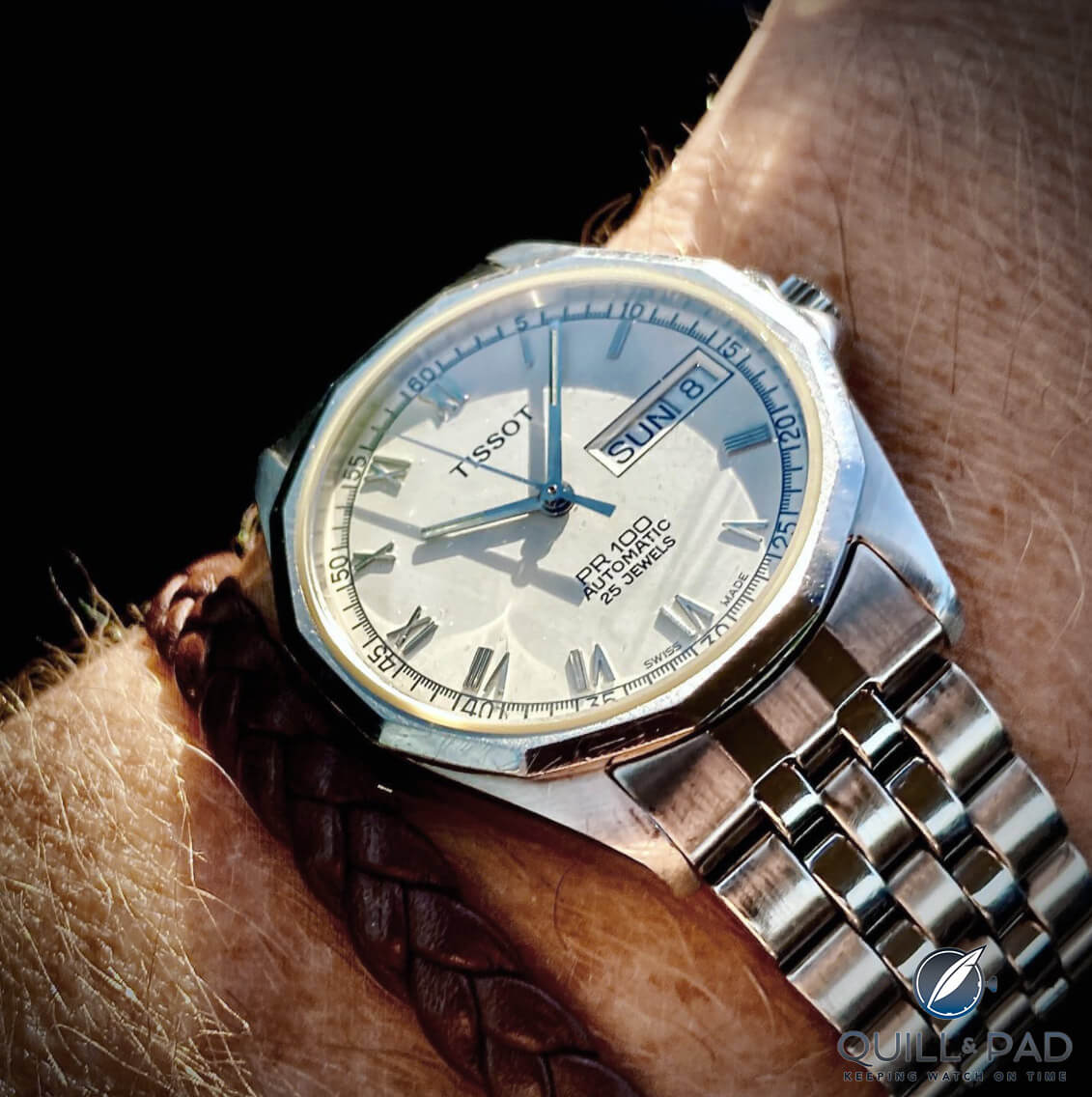
Tissot PR100 automatic (photo courtesy Colin Alexander Smith)
This model also came in a two-tone chronograph version with a Valjoux 7750 movement and is the predecessor of Tissot’s current PR100 Powermatic 80 range, in which the movement has been slowed down to 21,600 vph to provide an 80-hour power reserve. The PR100 was also available in an officially C.O.S.C.-certified version – this one isn’t, but clearly aspires to it as it runs at a steady +/- three seconds per day.
2001: Oris Artelier
On a family holiday to Dubai in 2001, my wife returned from one of her regular air-conditioned shopping mall sorties bearing this Oris Artelier for me as a surprise gift. It originally came on a skinny snakeskin strap, and I didn’t really bond with it until I paired it with this flat-link steel bracelet by Orient, which I had picked up in a batch of used bracelets on eBay, making it an excellent candidate for Royal Oak-style twinkly wrist rolls.
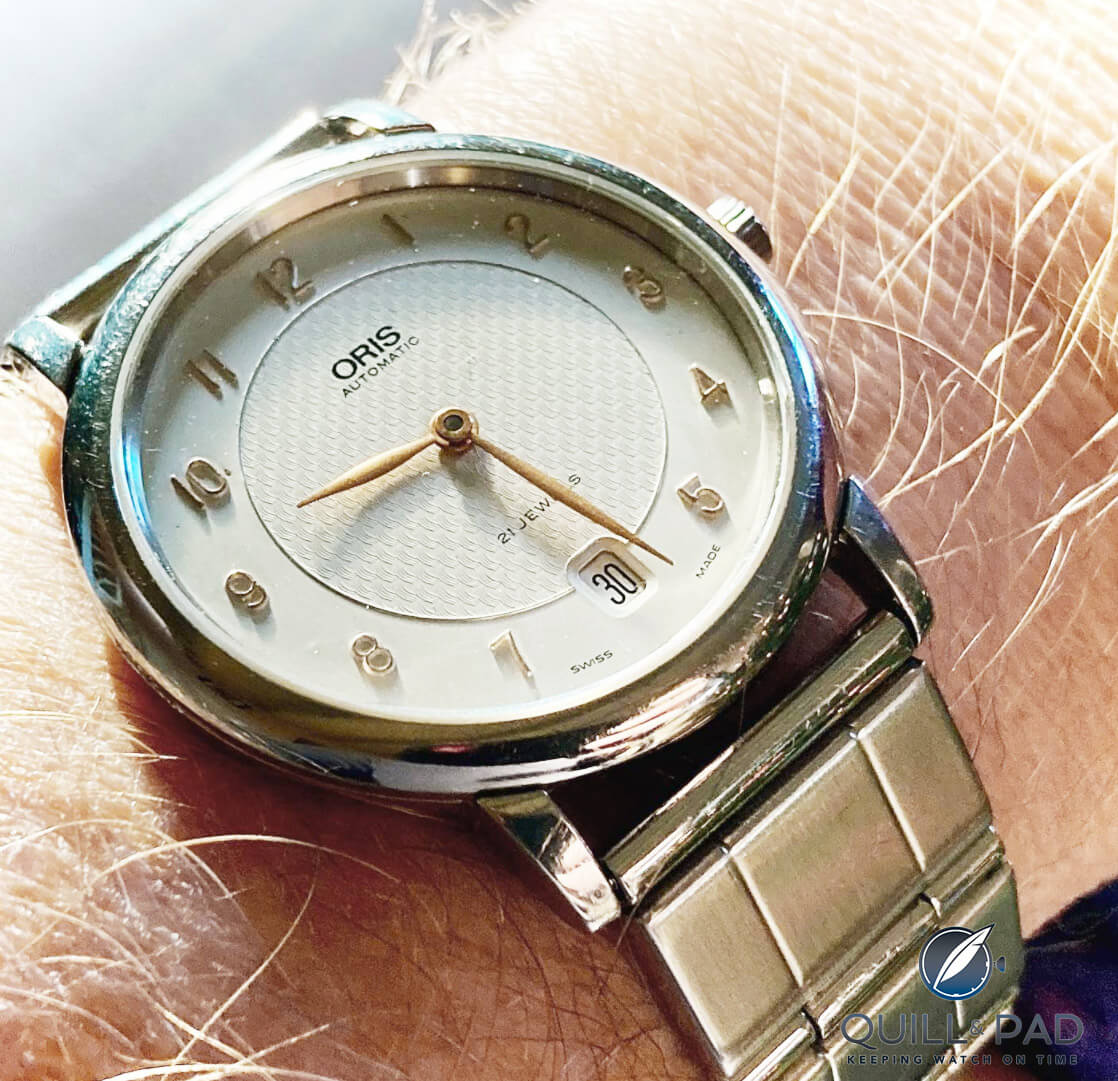
Oris Artelier (photo courtesy Colin Alexander Smith)
It’s an ideal summer watch as the case is a super-slim 8 mm thanks to the ETA 2892-2 movement (same as in the Tissot) and I think this bracelet gives it a sportier look. But what I like most about it is the absence of a second hand (which also made it possible to reduce the case height).
Sometimes it’s nice to be able to check the time without being reminded of its relentless passing!
2008: Seiko SKX013 with Pepsi bezel
This Seiko SKX013 is the most recent acquisition that has actually stayed in my collection, picked up on a whim a few years ago on France’s Craigslist, Leboncoin, for €100. The SKX013 normally comes with a black bezel, so I suspect someone swapped this out with a Pepsi to make it look like a SKX015.
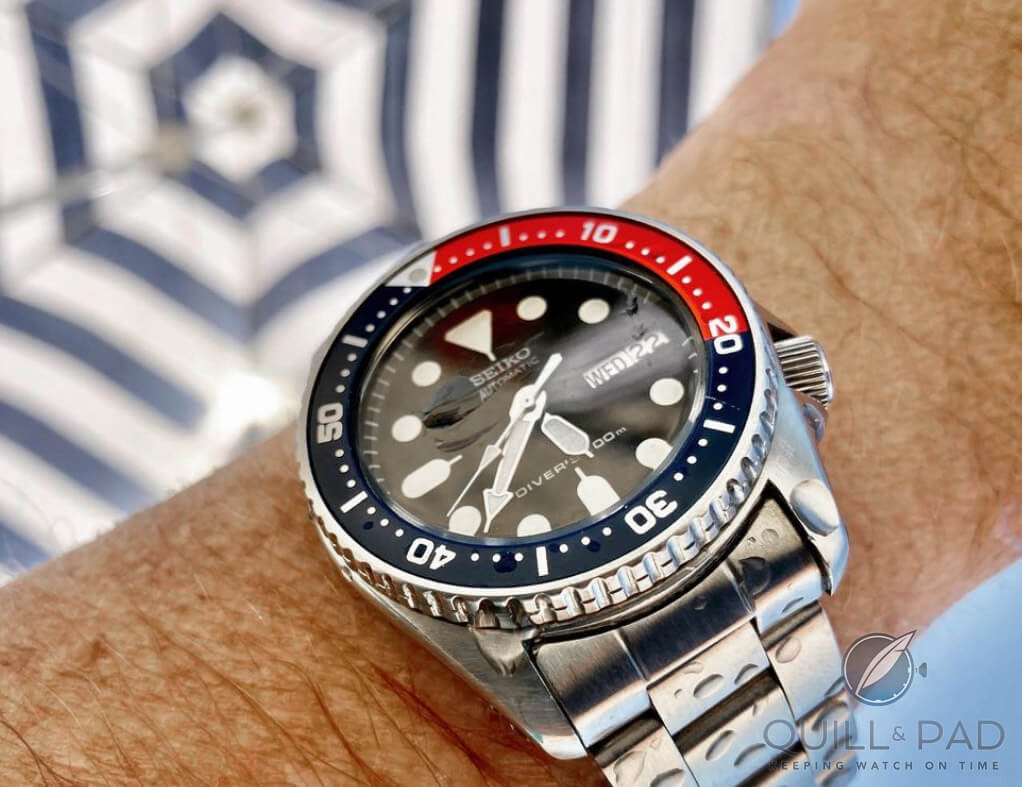
Seiko SKX013 with Pepsi bezel (photo courtesy Colin Alexander Smith)
The SKX013/015 divers fit my wrist better than the ubiquitous SKX007, so I was pleased to find one of these before Seiko stopped producing them and second-hand prices began to rise sharply, in part due to strong demand from Seiko modders, for whom these watches are a staple.
The movement is the 7S26, broadly similar to the 7025 in my 1979 Seiko, and after servicing and regulating it I have got it running far better than the +/-45 seconds advertised by Seiko.
I have actually used this watch while diving, which you can read about here.
So what’s next?
As for the future of my collection, I am torn in two very different directions: seeking out a hand-wound Cartier (or Must de Cartier) Tank or a 36 mm Tudor Submariner. This is probably an expression of some sort of late middle-age horological identity crisis.
The Tudor is likely to win out: as fellow Quill & Pad contributor Martin Green would probably point out, I would have to start dressing like a gentleman to be able to carry off the Cartier convincingly.
* This article was first published 01 March 2022 at The Unintentional Watch Collector: An Unplanned Watch Collection Spanning Eight Decades
You may also enjoy:
Tracing The History Of My Grandfather’s Pocket Watch And Delving Into English Watchmaking
Gerontohorologyphobia: A Young Man’s Fear Of Being Seen Wearing An Old Man’s Watch
Depth-Testing My Seiko SKX013 Dive Watch: Jumping In At The Deep End



Leave a Reply
Want to join the discussion?Feel free to contribute!